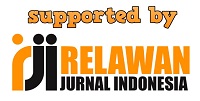Edukasi Pentingnya Pengetahuan Ibu dalam Upaya Mencegah Terjadinya Stunting pada Balita di Desa Sidomulyo Kabupaten Tulungagung
DOI: 10.29241/jaj.v3i1.1955Author
Puryanti Puryanti(1*), Emilya Indahyati(2), Alya Rizq Hanifah(3)(1) STIKES Yayasan RS. Dr. Soetomo
(2) STIKES Yayasan RS. Dr. Soetomo
(3) STIKES Yayasan RS. Dr. Soetomo
(1*) Corresponding Author
Full Text
Full Text: View / Download PDFArticle Metrics
Abstract View : 197 times;
PDF
: 197 times;
PDF  Download : 130 times
Download : 130 times
Abstract
Keywords
References
1. Nasution IS, Susilawati S. Analisis faktor penyebab kejadian stunting pada balita usia 0-59 bulan. FLORONA J Ilm Kesehat. 2022;1(2):82–7. https://doi.org/10.55904/florona.v1i2.313
2. Noorhasanah E, Tauhidah NI. Hubungan Pola Asuh Ibu dengan Kejadian Stunting Anak Usia 12-59 Bulan. J Ilmu Keperawatan Anak. 2021;4(1):37–42. https://doi.org/10.32584/jika.v4i1.959
3. Yoga IT, Rokhaidah. Pengetahuan Ibu Tentang Stunting Pada Balita Di Posyandu Desa Segarajaya. Indones J Heal Dev. 2020;2(3):183–92. https://doi.org/10.52021/ijhd.v2i3.74
4. Citra Palupi K, Sa’pang M, Swasmilaksmita PD. Edukasi Gizi Seimbang Pada Anak Sekolah Dasar Di Kecamatan Cilincing Jakarta Utara. J Abdimas [Internet]. 2018;5(1):49–53. Available from: https://www.esaunggul.ac.id/wp-content/uploads/2018/02/9.-Edukasi-Gizi-Seimbang-Pada-Anak-Sekolah-Dasar-Di-Kecamatan-Cilincing-Jakarta-Utara.pdf
5. Aurima J, Susaldi S, Agustina N, Masturoh A, Rahmawati R, Tresiana Monika Madhe M. Faktor-Faktor yang Berhubungan dengan Kejadian Stunting pada Balita di Indonesia. Open Access Jakarta J Heal Sci. 2021;1(2):43–8. https://doi.org/10.53801/oajjhs.v1i3.23
6. Rikesda T. Laporan Riskesdas 2018 Nasional’. Jakarta: Lembaga Penerbit Balitbangkes; 2018. Available from: https://repository.badankebijakan.kemkes.go.id/id/eprint/3514/
7. Prasetyorini A, Kamilah AN, Ardhana AP. Penerapan strategi promosi kesehatan rumah sakit melalui pemberdayaan pemberian makanan pendamping asi pada baduta stunting. J Abdimas Jatibara STIKES Yayasan RS Dr Soetomo. 2024;2(2):96–106. http://dx.doi.org/10.29241/jaj.v2i2.1823
Refbacks
- There are currently no refbacks.
Copyright (c) 2024 Jurnal Abdimas Jatibara

This work is licensed under a Creative Commons Attribution-ShareAlike 4.0 International License.




